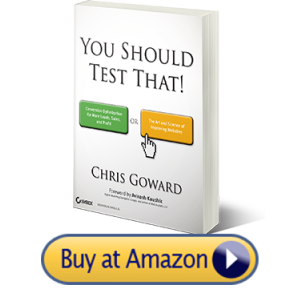"You Should Test That!" will teach you the processes, frameworks, and tactics that create winning businesses. It includes 15 full case studies of real tests plus many more examples of how companies are succeeding and failing in their websites and marketing. Join our chapter discussions to add your thoughts to the following chapter topics:
- Chapter 1 "Why You Should Test That"shows why testing and optimization are important for your success, the traditional website redesign is broken, and so called "best practices" are not best.
- Chapter 2 "What Is Conversion Optimization?"introduces the scientific testing method, dispels common myths of conversion optimization, and shows how to align your business goals with your website conversion goals. A case study in this chapter shows how a multi-test conversion-optimization strategy improved website content engagement for a tourism organization.
- Chapter 3 "Prioritizing Testing Opportunities" gets into practical steps to prioritize your testing opportunities using the PIE Framework to organize your web analytics and heuristic analysis and offers an affiliate marketing case-study example.
- Chapter 4 "Create Hypotheses with the LIFT Model" defines the LIFT Model heuristic analysis framework and introduces the following six chapters that show how to use that framework to develop great test hypotheses.
- Chapter 5 "Optimize Your Value Proposition" digs into the concept of the value-proposition equation and how to test all aspects of your tangible features, intangible benefits and costs. A case study with Electronic Arts demonstrates how a conversion-optimization strategy doubled the game registration conversion rate for The Sims 3.
- Chapter 6 "Optimize for Relevance" shows how to optimize the four aspects of relevance—source, target audience, navigation, and competitive—and includes an e-commerce case study of a dramatic home page redesign test and another multivariate test case study.
- Chapter 7 "Optimize for Clarity" gives guidelines and examples for enhancing the clarity of your information hierarchy, design, call to action, and copywriting, with three case studies, including a landing-page test for SAP.
- Chapter 8 "Optimize for Anxiety" shows how to turn anxiety in your favor and reduce your prospects' concerns about privacy, usability, effort, and fulfillment. An e-commerce case study shows a 42% increase in revenue per visitor.
- Chapter 9 "Optimize for Distraction" gives many examples of how distraction factors can reduce conversion rates, and how you can test to fix them.
- Chapter 10 "Optimize for Urgency" will help you test the effects of internal and external urgency and make sure your test results are valid in any season.
- Chapter 11 "Test Your Hypotheses"wraps up the hypothesis-development chapters and shows how to build a strong testing plan with the right goals, test areas, test types, and hypotheses isolations. The chapter also includes a case study and tips on how to get great test results.
- Chapter 12 "Analyze Your Test Results" gives guidelines for monitoring tests and analyzing them for reliable results and marketing insights.
- Chapter 13 "Strategic Marketing Optimization" is your call to action to become your organization's SMO champion and advocate a culture of continuous improvement.









